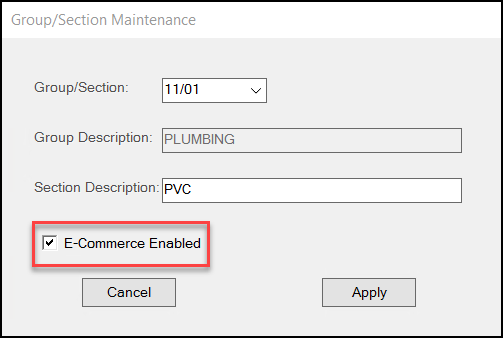Building your Ecommerce Solution with RockSolid MAX
When you are ready to build an ecommerce solution that gives you new ways to serve your customers remotely, ECI can provide two options.
Ecommerce API
We can provide our ecommerce API documentation to third-party developers you choose so they can have secure and reliable access to your application data. If you have this expertise in-house, this might also be a good way to manage the whole platform under one roof. The Ecommerce API provides access to your RockSolid MAX data, including your inventory, pricing, account, and other financial information. Your website can use the API tools to submit orders, quotes, and allow your customers to make account payments online. You can set up group notifications so your team always knows when new requests come in and there are process that allow them to import incoming orders / quotes so you can arrange for customer pickups and deliveries. Account payments, submitted by your customers online, can be processed automatically or manually as works best for your business.
Spruce eCommerce
You can also choose a new integrated solution, Spruce eCommerce that has your RockSolid MAX inventory and pricing integrated into your website more elementally. Spruce eCommerce provides all of the security and accessibility described in the original ecommerce API-based platform described above, plus the integration of
Note: We show the instructions using Spruce screen shots but they work the same way for RockSolid MAX installations.
A Note about Cloud Hosted and On Prem API Updates
When we upgrade the application in the Hosted environment the application contains the new links to the new API by default. On-prem systems rely on an automated process that is triggered nightly by the Spruce services running on their SQL server, which checks for and downloads and installs updates to the SpruceWeb web service. This on-premise process is not always reliable, due to local environmental setups (including Servers and Network infrastructure) which can result in their SpruceWeb web service not being updated to the latest release.
Accessing the API Guide
The Ecommerce API Guide lists the SOAP-based API tools your developers have to access the information in your application's database. Make sure you have shared the appropriate version of the Guide with your website development team so they have what they need to query the application for the information you have stored. The API Guide version should match the version of the application you are running. We develop methods over time and the application can only use the tools in the versions up to the version you are currently running. To obtain the Ecommerce API Guide, contact your After Market Sales Account Manager.
Setting up the Ecommerce Infrastructure
Setting up the ecommerce processes is part ECI's Implementation/Support team's responsibility and part your team's work. In this section, we cover the content that you can see so that you know that the pieces are in place when you do your part. Before you begin, the ECI team enables the Ecommerce parameter and ensures that the Master Branch setting is populated in the Parameter Settings > Software tab. We have enabled SpruceWeb and set up the URLs the website can use to access the application information. We create a unique API key, to provide a secure identifier for the connection between the website and the application. We verify that SpruceWeb can connect to the website and verify that we have resolved any application synchronization issues. Finally, we share the public URL or IP Service address and the API key with you. Share this information with the web development team and you are ready to set up your own ecommerce parameters.
After you send this information to your developers, there are several steps you need to take to prepare your system for the ecommerce order/quote/payment processes:
-
Set up the ecommerce parameters
We cover this in detail in the Ecommerce Tab Settings topic. -
Set up the user permissions for team members who will process ecommerce requests.
This will give the team members you are trusting with these tasks the ability to handle the records that come in. See Setting up the User Records for Processing Ecommerce Requests. -
Set up the branches and branch-specific notifications.
Use these instructions to enable the branch to receive ecommerce requests and if needed, add branch-specific notifications for users or groups you want to handle these records. See Setting up Branches for Ecommerce and Branch Notification. -
Set up inventory for ecommerce orders and quotes.
To make the items in your inventory accessible to your ecommerce website, you need to enable them in the application. Any items you do not enable will not be visible to ecommerce customers. You can include the standard items in this list, plus the following tally item types: Random Length, Pull to Length, Metal, Fixed Length, UOM-based Tally items, and Lot Tally items. You can enable individual items using the instruction in Enabling_Items_for_Ecommerce_Individually, or you can enable a group/section of items using the instructions in Enabling_Group/Section_Items_for_Ecommerce_Requests -
Set up Accounts for Online Payment Processing
In these instructions you can set the payment posting rule (that is, whether the payment is posted automatically as specified by the account member) to apply to accounts automatically either by selecting them globally or by setting them individually. You may want to use a combination of these instructions if you have some accounts that are problematic to work with. See Setting up Online Payment Processing for Accounts (Group) and Setting up Online Payment Processing for an Account.
Note: All online account payments require a Card On File to process. See Adding a Card on File to an Account/Job for these instructions. -
Set up an Ecommerce Cash Drawer for Tracking Online Order Deposits and Account Payments
When this set up is complete, you can use the Ecommerce Cash Drawer to track incoming online transactions by branch. You must have branch administration settings to make these changes. See Setting up the Ecommerce Cash Drawer for these instructions.
This should complete the set up required for online order, quote, and payment processing.
Note: There are some additional settings available for Spruce eCommerce-based websites, which you can learn about here.
Setting up the User Permissions for Processing Ecommerce Requests
Choose the permissions for ecommerce order processing carefully. There are specific user settings for ecommerce orders, which are described here. These users must have rights to manage Card On File payments, particularly in cases where the Card on File process fails. When the user ID settings for the person or persons that will be processing online orders, you can set up your notification information for the system and the branches.
To enable these permissions settings for a user:
1. From the Main Menu, choose Maintenance > Database > User IDs to display the User ID Maintenance form.
2. From the User ID list, choose the ID of the person or group to whom you want to give these permissions. The form updates to show the user’s existing settings.
3. Make sure the user’s Email address field has their current email address entered and the check box, Get notifications and messages via email is selected.
4. Choose the Application Security Settings ![]() icon to display the list of security settings.
icon to display the list of security settings.
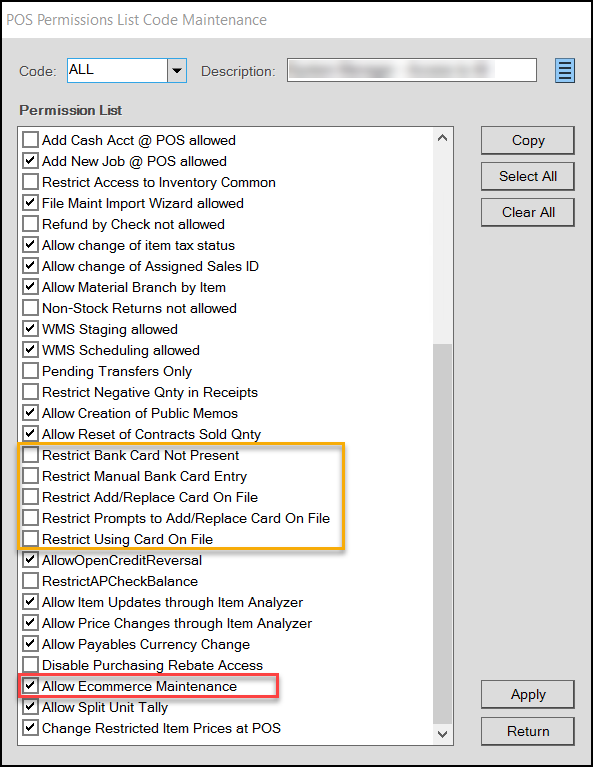
POS Permissions List Code Maintenance with Ecommerce-Specific Entries
5. Scroll down through the list and check the Allow Ecommerce Maintenance box.
This gives users the rights they need to modify incoming ecommerce records when needed.
6. Take note of the following bankcard entries for this user and ensure they are not selected for this user:
• Restrict Bank Card Not Present
• Restrict Manual Bank Card Entry
• Restrict Add/Replace Card on File
• Restrict Prompts to Add/Replace Card On File
• Restrict Using Card On File
7. Choose Apply and then Return.
8. Choose Process (F12).
9. Log out of the application and log back in using the User ID you just enabled so you can validate these entries.
Now this user is ready to process and close ecommerce orders or quotes.
Note: This user cannot void these orders, but you can reject and close them.
Deposit Note: If the user is closing an order and the order has a deposit associated with it, they need to process the refund on the account before they can close the order.
Setting up Branches for Ecommerce and User Notification
We have expanded our support for branch-based ecommerce options to allow branch personnel to process incoming orders/payments/quotes. To enable your branch to receive and process ecommerce business that is specific to their location, complete the following settings. You must have administrative permissions to access these settings. If you do not set branch-specific notification settings, the application uses the system settings described above.
1. From the Main Menu, choose Maintenance > Database > Branches to display the Branch Setup form.
2. In the Branch ID field, choose the branch you want to enable ecommerce processing for.
3. Choose the Ecommerce tab.

Branch Setup Form with Ecommerce Tab Options Displaying
4. Select the Enable ecommerce for this branch check box.
5. In the Notify User or Group list, choose the User ID of the person or group that you want to notify when the application receives ecommerce orders.
Note: The application will use the entry you have selected here when the incoming orders are specific to this branch. If you do not select this option for this branch, the application uses the parameter set in the Parameters > Point of Sale > Ecommerce tab instead.
6. When you have completed these entries, choose Process (F12) to save the settings.
Complete these steps for each branch you will sell items from on your website.
Note: There are two notification options for the users specified in these fields. The application can use the email address of the user and send an email when new online requests come in for the current branch or the user can use the Messages feature to review incoming notifications that are assigned to them. To learn more about the Messages feature, see Reviewing Messages in the Notification Queue.
Reviewing Messages in the Notifications Queue
When you receive ecommerce request notifications, you can access them in a couple of ways. You can look them up in your email application or you can review the messages associated you their application login by clicking the Messages icon at the bottom of the Main Menu. This icon shows the number of messages to be processed.
![]()
Messages Icon
When you click the Messages icon, the Notification Queue displays the messages the application has sent based on your user notification settings. These messages in the queue are related to any system notification permissions for which you User ID is enabled, so it may not be just ecommerce orders, quotes, or payments processing.
Note: The application does not send user notifications for auto-processed payments or orders.
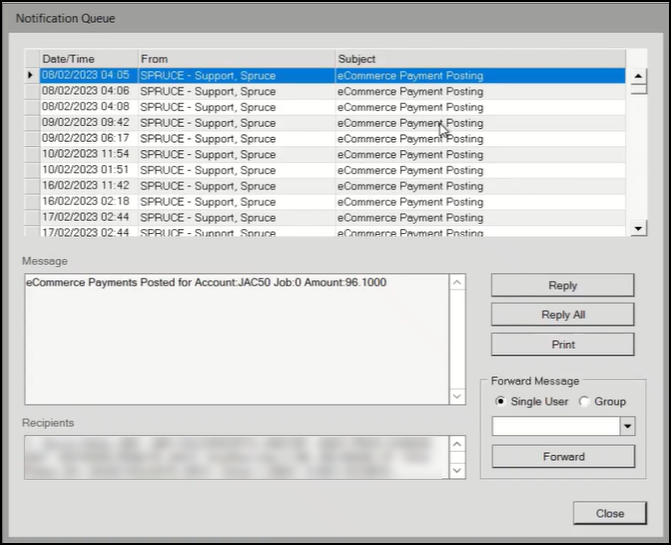
Notification Queue
Enabling Group/Section Items for Ecommerce Requests
You can enable stock for ecommerce requests by group and section and by selecting individual items.
To enable the ecommerce option for a group/section:
1. From the Main Menu, choose Inventory > Database > Parameters > Item to display the Item Maintenance form.
2. In the Group/Section list, choose the group and section you want to enable for ecommerce.
3. Beside the Group/Section list, choose Settings ![]() icon to display the Group/Section Maintenance box.
icon to display the Group/Section Maintenance box.
Group/Section Maintenance Box with E-Commerce Enabled
Note: To enable a subset of this group’s items for ecommerce, we recommend that you create a new ecommerce section to which you add only ecommerce-enabled items. Type a new name in the Section Description field to create this new section on the spot. Later they can reclassify the items they want to include using this new section name.
4. Select the E-Commerce Enabled check box to allow the items with the Group/Section settings specified to be sold online.
5. Choose Apply to redisplay the Item Maintenance form.
6. Choose Process (F12) to save this setting.
Enabling Items for Ecommerce Individually
Businesses can set up individual items for ecommerce orders as well. Any items that are not enabled for ecommerce should not be listed on the customer’s online store.
To set up an item for online sale:
1. From the Main Menu, choose Inventory > Database > Item to display the Item Maintenance form.
2. From the Item list, choose the item you want to enable for ecommerce (sale online).
3. Choose the Common tab and the ECommerce tab to display the ecommerce settings for this item.
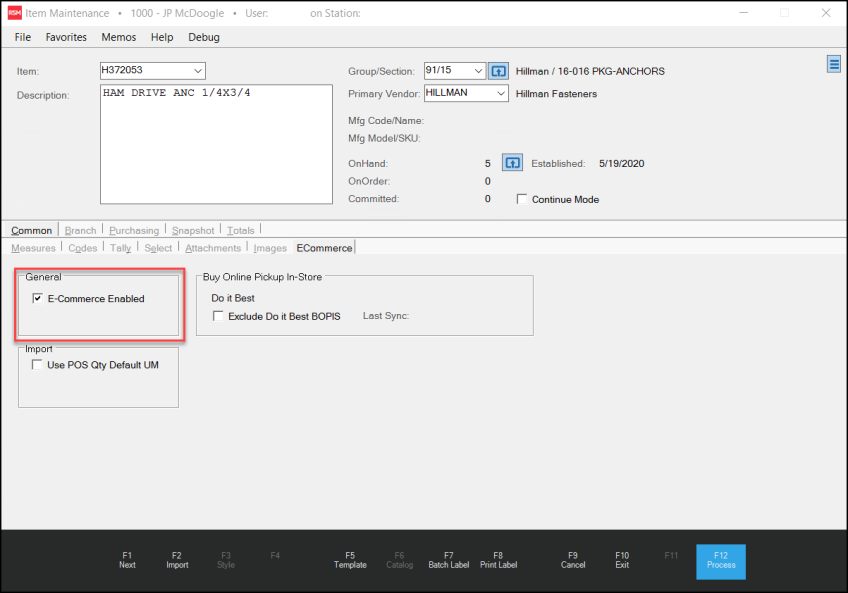
Item Maintenance > Ecommerce Tab
4. Select the E-Commerce Enabled check box.
Note: Items that do not have this check box enabled are not eligible for ecommerce orders and do not appear in the list. This is set globally for items that are enabled by group/section as discussed in Enabling Group/Section Items for Ecommerce.
5. If you work with Do it Best as a vendor, consider whether you want to exclude this item from the BOPIS program. If you do, choose the Exclude Do It Best BOPIS check box.
6. If, when you import this item in an ecommerce order, you want the application to modify the quantity submitted to match the default unit of measure, select the Use POS Qty Default UM check box. When this check box is enabled, and you import an ecommerce order with this item, if it contains a different unit of measure than is stored in the Default Unit of Measure Settings > POS Quantity field (in Item Maintenance), the application will convert that unit of measure and adjust the quantity for internal teams. This makes it easier for your picking team to collect the items needed to fulfill the order quickly. This will not change the pricing values of the imported order. You can set this option for some items and not others, if you wish.
Note: This setting is not required unless you want to use this conversion process for the internal collection of order materials. This check box is not enabled by default.
7. Choose Process (F12) to save this entry.
Setting Up Online Payment Processing for Accounts (Group)
If your business allows online payments, the application can process those payments automatically using the Payment Processing Rules. You can set this option globally and, for particular accounts, you can specify whether the payment is applied as the customer requests or not. This is true for both Balance Forward and Open Item accounts and allows for third-party payments to these accounts.
The application accepts payments for ecommerce orders for accounts with Card On File settings automatically. The customer may also apply Convenience Fees for this process, as allowing customers to pay online using a card on file incurs extra fees for their business.
To set the online payment posting rule for many accounts (globally):
1. From the Main Menu, choose Receivables > Utilities > Account Global Modify to display the Account Global Modify form.
2. From the Field Name list, choose Payment Posting Rule.
Note: Since this feature is new, there are no existing values.

Account Global Modify with Payment Posting Rule Selected
3. In the New Value list, choose the value you want to apply to the selected accounts. Options include:
-
Post allocations as requested
Choose this option to post online payments to account balances automatically. -
Post ignore allocation request
Choose this option to prevent account payments using this posting process.
4. In the Filter box select the criteria for which this value should apply.
Here you are looking for the accounts you want this rule to apply to.
5. Choose View (F8) to collect the accounts that match the filter criteria.
6. Review the list to ensure that they include the accounts you want.
7. When the list of accounts is right, choose Process (F12) to save this setting to each account.
Setting Up Online Payment Processing for an Account
You may want to prevent a particular account from posting their payments online automatically. Typically, if there is a card on file problem for an account, this might be the case.
To set an account’s online payment handling:
1. From the Main Menu, choose Receivables > Database > Account to display the Account Maintenance form.
2. From the Account list, choose the account that you want to set the online payment handling for. The account details display.
3. Click the Ecommerce tab to display the Payment Posting Rule that is currently associated with the account.
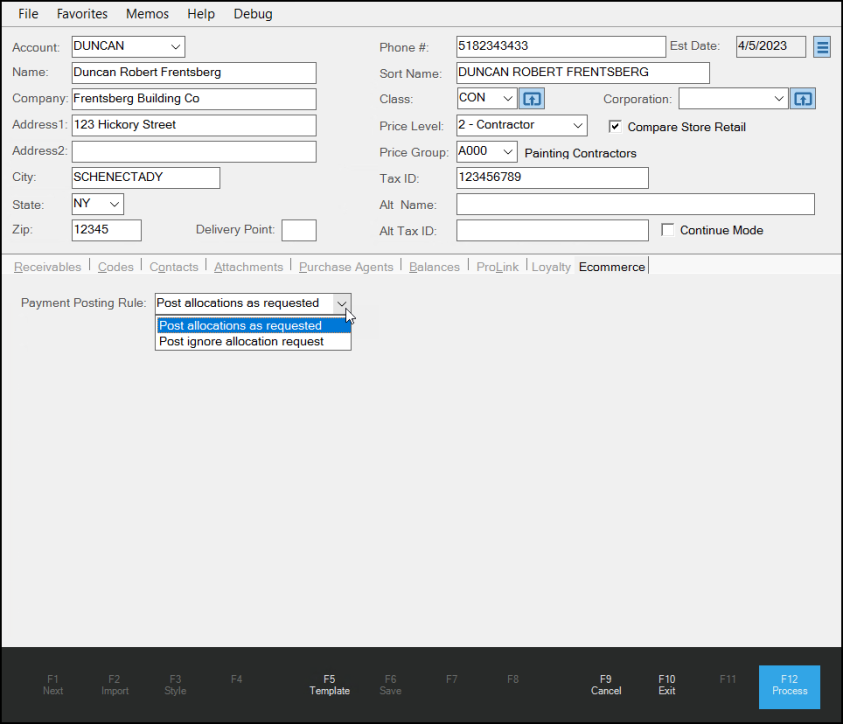
(Receivables) Account Maintenance > Ecommerce Tab > Payment Posting Rule List
4. Select the other ecommerce payment posting rule you want to use for this account.
5. Choose Process (F12) to save this setting.
Processing Ecommerce Submissions (Orders/Quotes)
After a customer submits an order or quote online, the submission should be either processed or rejected by your company. The ecommerce order, quote, or payment doesn't become an actual transactions until someone at your company imports them and processes them. The process is the same for orders and quotes, so we show the order process here. Quotes don't have payments associated with them, typically, but essentially the process is the same. When a customer that does not have a receivables account submits an online order, you can use the Cash account to process the transaction.
To process an ecommerce order or quote:
1. From the Main Menu, choose Point of Sale > <Orders or Quotes>. The appropriate entry form displays.
2. Choose the required account or choose the Cash account and click Tab to add a new Order number. The Import (F2) key enables.
Note: For some accounts the Job # entry is required.
3. Choose Import (F2) and from the context menu, choose the E-Commerce menu item.
The Import E-Commerce Quote/Order dialog box displays. In the ID list, only orders or quotes that match the customer ID you selected display. If a particular submission is assigned to a job other than the transaction's current job selection, the application will update the transaction to reference the submission's job after the submission is complete.
For Cash accounts, you may need to obtain some order information from the customer to identify the order in the list.

4. From the ID list, choose the transaction you want to process.
A Note About Deleting an Ecommerce Transaction. You can delete a transaction at this point if you need to clear a duplicate submission or remove a canceled request at the direction of a customer. To delete an ecommerce request, click the Menu Marker ![]() icon and select the Delete option.
icon and select the Delete option.

A confirmation prompt displays. Choose Yes to delete the order or quote. You must have specific permissions to perform this action.
You must delete an ecommerce submission before you accept it. This is not the same as rejecting an order or quote (see the IMPORTANT! message below).
5. To import the selected ecommerce transaction, choose Accept.
The items listed in the transaction populate the data grid. After you accept an order you have two options. You can reject the order/quote (as when you don't have the stock to fulfill the order) or you can process the order. If you need to reject the online ecommerce order, see Rejecting an Ecommerce Order/Quote.
6. Review the transaction details to see if there are any changes and to verify that the materials the customer has are the ones they ordered. Typically, online orders are paid in full using a third-party processor, so you do not need to process a payment for these transactions.
However, if the customer only paid a deposit, the application may prompt you to process the payment for the balance. In these cases, it is usually for an account that has a card on file, so you would process the payment using that payment method. You may also process the remaining payment to the account as a charge, if the customer wants to use that option. We recommend that you contact the account customers directly if you are not sure how this process should work for this transaction.
7. When you are ready to process the transaction, choose Process (F12). The appropriate process Document displays.
8. Complete any adjustments or delivery steps that are required for this transaction and choose Finish (F12) to complete the process.
A Note About Importing UOM Tally Items in Ecommerce Orders
When you sell UOM-based tally items online, how the application handles the order import process depends on the platform (Spruce eCommerce or Ecommerce API) you use to do business.
-
Spruce eCommerce
For this platform, the application only allows an overall tally quantity during the order process.
The application converts the tally quantity into the individual UOM quantities supported at Point of Sale. -
Ecommerce API
For this platform, the application only allows an overall tally quantity during the order process. The processing is managed slightly differently for manually processed and auto-processed orders-
If the order includes a UOM tally item and is auto-processed, the application saves the tally item quantity details with the customer order and displays these quantities in the item's Description field on the order document.
-
If the order includes a UOM tally item and is manually imported and processed, the application displays the UOM quantities and totals (in the Unit of Measure Tally box) when you click the Description field after importing the order into the data grid. This ensures the UOM tally item order details display correctly for internal picking teams and in the order document.
-
Rejecting an Ecommerce Order/Quote
Rejected submissions remain available for processing in the future. They display in the Import E-Commerce Quote/Order ID list with the reason selected in the Status column.
To reject an ecommerce transaction after accepting the transaction and displaying it in the data grid:
1. Click the Menu Marker ![]() icon next to the data grid and choose the Reject E-Commerce Order option.
icon next to the data grid and choose the Reject E-Commerce Order option.
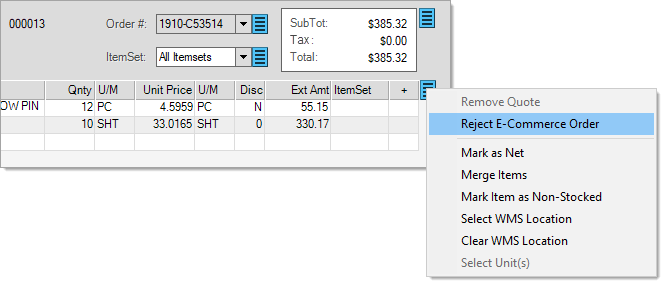
The Reject E-Commerce Quote/Order box displays.
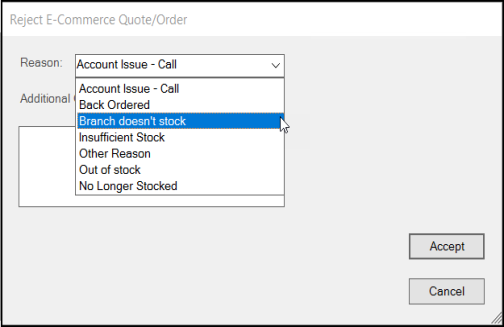
2. From the Reason list, choose the reason for the rejection of the transaction and enter any detail needed in the Additional Comments field.
3. Click Accept to process the rejection.
The application saves the reason code and the message with the submission. The application sends a notification to the customer (if they have an email address associated with the account's billing contact) whenever an ecommerce submission is rejected.
|
Important! Deleting a submission is not the same as Rejecting a submission. Deleting does not send any notification to the customer and the submission is removed from the application permanently. Rejecting a submission notifies the customer that there is an issue and allows you to choose a reason and type in a message regarding the problem. Rejected submissions are not removed and do remain available for future processing in the event that the issue is resolved. For these reasons, deletion should only be used for clearing duplicate submissions, old rejected submissions, or removing an unwanted submission at the direction of a customer, for example. |
What if I accept an ecommerce request and then cancel the transaction (Cancel (F9))?
Canceling leaves the submission untouched. It will remain available for future selection and processing (or later rejection).
What happens if I reject an ecommerce quote or order?
The quote or order remains available for future processing, but the application updates the record with the rejection status and comment. The application sends the customer a notification (if the email address is available). They can also see that the order or quote was rejected in the ProLink app (under either Orders or Quotes). The application also updates the record for display in the website.
What happens after I process an ecommerce order or quote?
If the account's primary (billing) contact has an associated and valid email address, the application sends an email notification that their order or quote was processed (when you have enabled the Confirmation Emails settings in the Ecommerce parameters). In addition to this notification, the customer can check the website to see when their order or quote has been processed (approved).
How can I view ALL ecommerce order/quotes?
Yes. Go to Inquiry > E-Commerce (E-Commerce Inquiry) to view all or selected order or quote requests with item details.
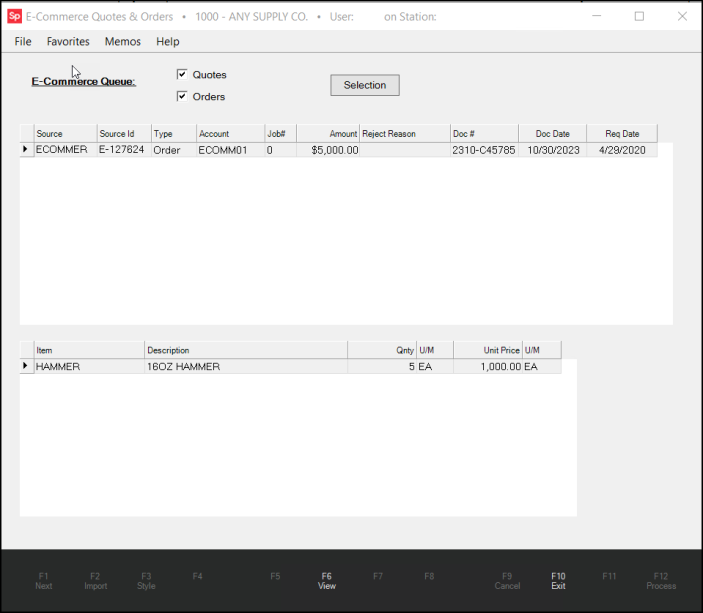
One other option is to use the system CASH account in either an Order or Quote transaction and then choose Import (F2), E-Commerce. All orders or quotes are listed when the CASH account is being used. After a selection is made, the transaction's account and job are reset to match the account and job assigned to the submission.
Note: If you are looking for a Spruce eCommerce order (with a SPEC-specific ID), we keep track of this information in the Order and Sale documents linked to the transaction. You can use the Document Viewer to search for the ID by entering the seven-digit ID in the Notes field between two % symbols.
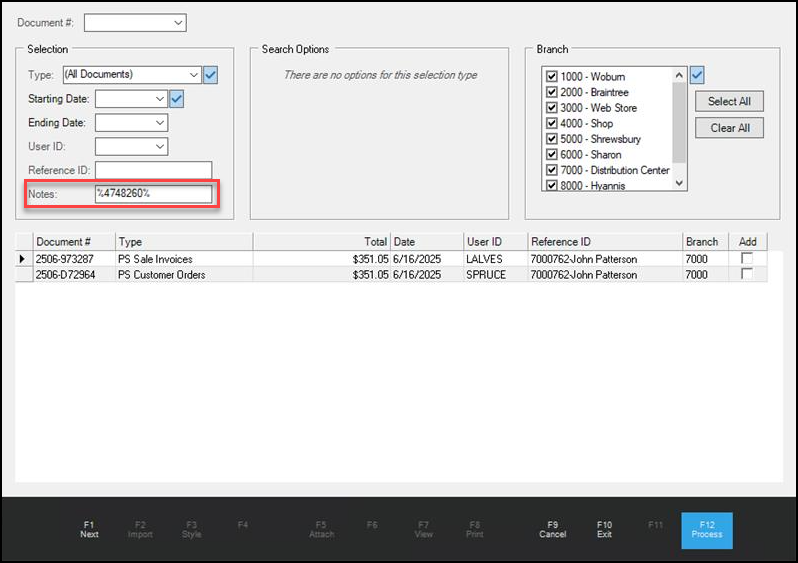
See Also:
Spruce eCommerce > Inventory Item Sync
Spruce eCommerce > Statement and Invoice Discounts
Other Ways to Access Ecommerce Data Stored in the Application
The software offers another ecommerce solution to help you manage your online presence and order and quote submission processes.
ProLink
ProLink is an app for Android™ and Apple® devices (such as iPad® and iPhone® devices) that gives your customers a way to view account information, shop and create quotes and orders, and view application-based documents online. The app is custom branded to match your company's identity. We build each company's app and host individually. The app is a hybrid combining native (device) code which integrates with web (Internet) based interface. The web host connects to your server via a secure API using components in the application. Due to potential changes between your software and data, the code on the web host must stay in sync with the changes (updates) are made on your server. This is done automatically once a day as necessary. ProLink is a separately licensed and priced product of ECI Software Solutions, Inc.. To learn more about RockSolid MAX ProLink, see this topic, ProLink in a Browser and review the ProLink video here. Then, contact your Sales Account Manager for RockSolid MAX ProLink pricing and purchase information.
